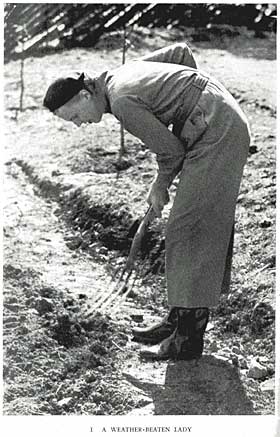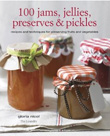HELLO GRANOLA WORLD
Monday February 25th 2008, 10:19 am
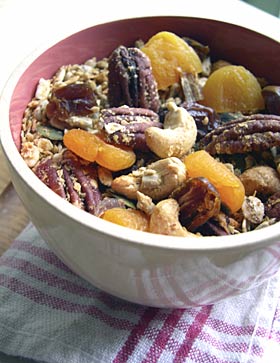
What did we ever do before the world wide web? I was curious to find out whether granola is a trade name or not and a quick Google search instantly told me it once was, still is in Australia but no longer is everywhere else. Wikipedia has come in for a lot of stick in the press recently for being unreliable as it is public participation that keeps the information it contains updated and accurate. That means you and me could make up any old tosh and contribute to an encyclopedia of pure bunkem, if we so wish.
According to Wiki-P, “Granola” is used as a slang term (metonym) describing a person who is hippie-like, a modern bohemian, environmentalist, or leftist in outlook. I have never heard anyone referred to as a ‘Granola’, though as insults go it could be worse. In fact I have decided to become a Granola.
I can’t believe that I’ve never made granola before, an oat-based whole-foodie concoction that contains seeds, nuts and grains and is slightly sweetened with honey, maple or sugar syrup. The combination of ingredients can be just about any mix you like and baking in the oven toasts it all nicely and heightens the flavours.
I am never sure whether it is good to make things that you can’t stop eating or better to not make them at all and for me granola falls into this category. The real jewels in the mix, the whole cashews, chopped apricots and toasted pecans sit on the top shouting ‘eat me’ and I duly oblige everytime I walk through the kitchen. Paul McKenna promotes a strange tapping technique to overcome cravings so I am often to be found in the kitchen staring at the jar of granola whilst tapping my head in the McKenna-style.
Granola is fabulous served with natural yoghurt for breakfast and full of good things to help keep you going all day. For a rather more special dessert, mix mascarpone with plain yoghurt, maple syrup and a spash of good vanilla extract and add the granola to that. Serve in precious little ramekins to make it seem even more special. Here is a recipe to get you started but really, this is a freeform thing, so go with the flow and improvise.
THE BEST THING SINCE SLICED BREAD IS ….
Monday February 18th 2008, 4:36 pm
NO-KNEAD BREAD
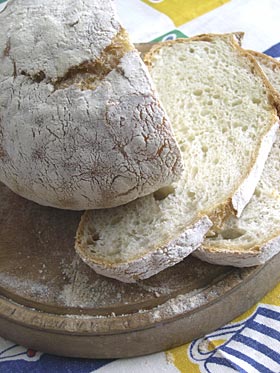
When I first started to learn about yeast cookery it was drummed into me that baking bread was a very tricky skill to crack. Yeasted dough had to be treated with great respect, kept out of draughts, not be subjected to shocks (slamming oven doors etc) kept at just the right temperature and be given sugar to feed it.
Last year I came across a recipe for no-knead bread which seemed to defy all the rules, turns bread making technique completely on its head and still manages to produce a fantastic looking loaf.
The technique, devised by Jim Lahey at the Sullivan Street Bakery in New York was picked up by The New York Times and subsequently created a buzz that quickly swept across America. As far as I am aware, it didn’t reach these shores, or perhaps I just turned my back for five minutes and missed it.
A couple of days ago I came across the recipe again and baked the no-knead loaf for the first time and was just amazed with the result. The ‘no-knead’ part of the title didn’t attract me to the recipe at all, I think most bread bakers like the kneading bit, but this recipe calls for virtually no attention and a considerable amount of time. You mix the dough in 3 minutes flat, then leave it untouched, at room temperature, for 12 – 18 – 24 hours, as long as you like, shape (the very wet) dough into a ball, leave to rise again for 2-3 hours, then, and this seems to be the magic bit, bake the loaf in a lidded cast iron pot, removing the lid for the last 20-30 minutes of cooking time. I’ve got a really great cast iron casserole I bought at Ikea and that worked wonderfully well. Apparently any lidded dish should suffice; pyrex, a terracotta bread crock etc, just make sure that it is totally oven proof.
The texture of the bread is remarkable, the crust is crunchy and crisp and my loaf looked like something I would have paid dearly for if I had bought it at a smart bakery. This morning it made lovely toast. Now I am going to experiment with other flour combinations and flavourings, I’m used to eating sourdough bread with all the rich flavours that offers so just a bit more oomph would make this loaf just about perfect.
Here is the recipe. It is really worth trying it out.
The only part that could be daunting is handling very wet dough. My advice is that after the long rise, scrape the dough out of the bowl with an oiled spatula, onto an oiled surface and use oiled hands to manipulate the dough, though it doesn’t call for much, if any, handling. You can then fold the dough a few times if you like and flour it only when shaping into a ball. Apparently well floured baking parchment is another alternative way to stop it sticking all over the place and driving you to distraction. Don’t be tempted to simply add more flour to make it manageable, it’s the water content that makes it so light and open and I’ve read reports of great results achieved without touching the dough at all.
HOW TO PEEL A POTATO
Sunday February 17th 2008, 2:02 pm
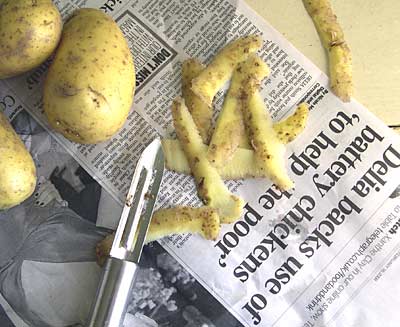
The other day I was watching a food programme on Sky 3 called Taste. They were doing a feature about what to ‘cook’ for a girlie night in using ready-made food and the presenter came out with the phrase, ‘I’m not suggesting you peel a potato’. I almost choked on hearing this and the words have been going round in my head ever since. God forbid, anyone should peel a potato and to suggest such a thing…well! Once upon a time life was too short to stuff a mushroom, now it’s too busy to peel a potato.
Yesterday I bought the Saturday papers including a paper with a feature about Delia and her upcoming new TV series and book, How To Cheat At Cooking, where she will be using pre-prepared bought-in ingredients, such as ready-made mashed potatoes, cook-in sauces and other ingredients that need to be hyphenated, to rustle up lovely meals in a moment. This is aimed at busy people who don’t have much time and are also quite poor so need to eat battery farmed chickens (quite obviously a distortion of the facts, in a nutshell, based on what I have read in the paper, Chinese-whispers-stylee, pass it on!). There are bound to be many words written about her and the series in the weeks ahead as she holds such an iconic status here in the UK and this series is her comeback, having retired from cookery writing 6 years ago to concentrate on her career as a footballer.
I must admit I hold her in the highest esteem myself, having learnt to cook with her. When I lived in two places I made sure the 3 part cookery course (the first time round version) and her Summer Collection were duplicated, one in each home, as I consider them to be ‘must haves’. I know many of the recipes especially from her earlier books by heart and on numerous occasions Delia recipes have been served up at momentus family gatherings. A sort of mythical Delia inhabits my families consciousness. She has an uncanny knack of being ahead of the game, like she just knows something the rest of us are struggling to put our finger on, but I am feeling very wobbly about this new theme she has embraced.
I am not a particular fan of the ‘quick and easy’ route to anything, just for the sake of it. Some things simply are quick and easy and still work brilliantly and that’s great, but there is something at the core of this that bothers me. I think we’ve got an obsession with being busy people. Most of us ARE busy, that’s a given, but the cult of busy is about making ourselves feel significant by banging on about how busy we are all the time. There is a huge industry out there catering for our busy lives and that relies on us buying into being really ‘busy people’. What came first, the chicken or the egg?
Go on, step outside the box. Find the time to peel a potato. Upend the cliche.

HOW TO MAKE MARMALADE
Tuesday February 12th 2008, 9:43 am

It wasn’t that straightforward finding Seville oranges this year and as the season is only for a few weeks straddling January and February I had to seek them out. I managed to order some in specially from the organic deli, which fortunately is very close by. When I went to the one and only greengrocers in the nearest town it had sadly closed down a week before. So Tesco has managed to put another independent out of business and another business that thought it was enough to just sell produce without the help of recipe cards and a loyalty points scheme has learnt the hard way.
Thankfully I now have some beautiful Seville oranges to cheer me up. Last year I made two lots of marmalade using different techniques to prepare the orange peel. For the first batch I pared and chopped all the peel at the beginning which takes ages but is a ritual with some therapeutic value, at least for the first half an hour or so until the novelty wears off. For the second batch I poached the oranges in my wonderful cast iron pot in the Rayburn for three hours then scooped out the innards and chopped the peel. I think the second method is the easiest and now definitely the one I prefer.
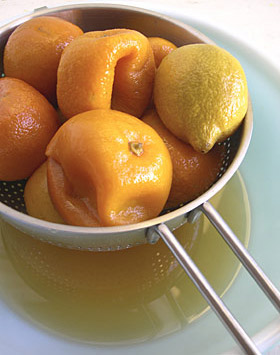
Some of the marmalade I made was beautifully glowing and orange, like looking through stained glass windows when holding the jars up to the light, the rest was slow cooked for several hours in the Rayburn till it ended up deep, dark, rich and caramelised. Both were lovely so I’d be hard pressed to choose which kind I prefer so am now making both types again this year. Find my recipe here.
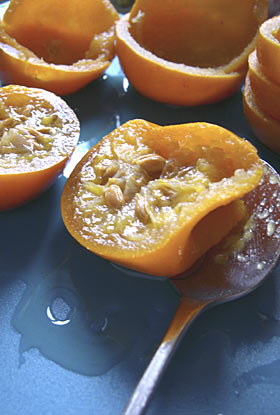
Seville oranges have such a strong character that they can withstand long cooking and still retain their own distinctive personality. You have to respect a fruit like that. It is worth putting some in the freezer so they’ll be available out of season for keeping the marmalade stock replenished, for making orange curd as well as for rustling up an impromptu bitter orange tart when called for. Just wash and dry the fruits, pack into plastic bags and seal before freezing.
ALL AT SIXES AND SEVENS
Wednesday February 06th 2008, 10:18 pm

Sometimes a little knowledge is a dangerous thing. Take for example, if you are already an experienced bread baker, then taking on board new techniques can turn everything on its head and leave you all at ‘sixes and sevens’ (whatever that means).
Before I started on my sourdough journey I had only ever proved my loaves on baking trays or in bread tins, the right way up. Now of course I know to prove my loaves upside down, like the artisan bakers do.
For the final rise the dough shapes should be proved upside down either nestling side by side divided by folds of floured linen (for batons and long shapes) or each in its own banneton, a basket meant especially for this purpose which is either made of coiled cane, which imprints a distinctive coil pattern on the top of the baked loaf, or alternatively a basket lined with linen. Once the dough has risen just right, you flip the loaf over onto a peel or paddle (or metal baking tray) dusted with semolina, so the loaf is then the right way up, and quick as a flash slash the top of the dough with a razor blade (called a lame if you are a real professional), spray it with water and with a quick flick shove the dough into the oven to bake.
The coiled bannetons are a professional bit of kit. You can buy them mail order from here but you can make your own linen lined baskets which look like the real deal. That’s what I’ve done and they work just fine. When you use them they need to be liberally dusted with flour and every now and again if you feel the need you can give them a quick going over with the vacuum cleaner. I can’t say that I ever have, I just whack them against the side of the sink to disslodge any loose flour, make sure they are good and dry and leave them till the next time.
Now lets make a linen-lined banneton. First take a piece of vintage French linen (stop laughing at the back) and a basket….. here’s how
CAN’T LIVE WITHOUT …..
Monday February 04th 2008, 2:45 pm

MAPLE SYRUP
Of course this is just to set the scene. More on maple syrup to come…..
HOW TO GROW FOOD
Sunday February 03rd 2008, 3:44 pm
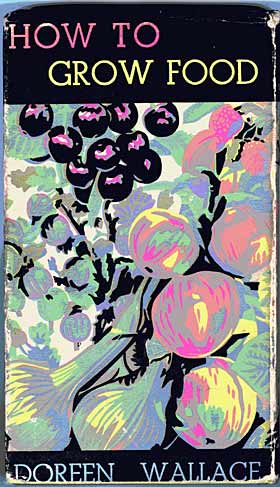
We are experiencing a bit of a cold snap this weekend, so I’ve got the Rayburn all warm and glowing and batches of damp, freshly-washed laundry are draped over it to dry. I call that a win, win situation.
Last weekend we had a surprisingly spring-like day on the Sunday. It could have been April. It was so warm and sunny that I sat outside, overlooking the vegetable garden and ate spicy squash soup (made using the only 2 squashes I managed to grow last year) and cheese scones (thanks Dan, fab Guardian recipe for scones here) in the sunshine.
It gave me time to peruse the veg plot and start to get my head in gear to begin planning what needs to be done, what I am going to grow and where I am going to grow it in the year ahead. One thing that is definitely my number one resolution is to try and plant the seeds on time. I am always full of ambitious plans, do a ton of research so I know all the varieties of lettuce and the seed merchants who sell them, then I buy them, then I miss my planting ‘window’ and it is all for nothing.
Best to try and not be quite so ambitious I suppose. Lets face it, gardening is a battle. You have to face all sorts of unexpected obstacles, freak weather conditions, disease and pestilence, and hope that at the end of it you end up with some salad on your plate. I’ve got a few evenings of planning ahead to decide what to grow where and I want to add a few more beds to what is there already. The great thing about a sunny day in January is that you suddenly feel raring to go and ready to begin all over again. Let the battle commence.
